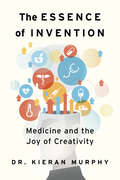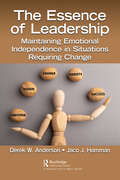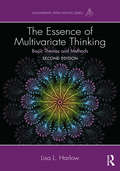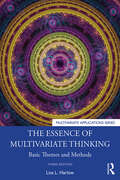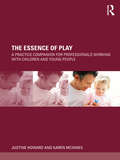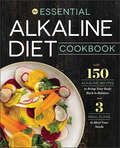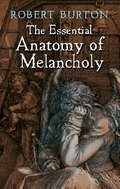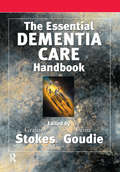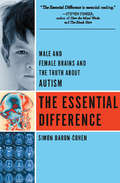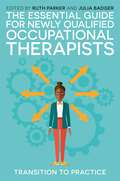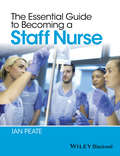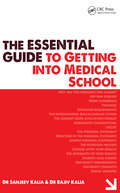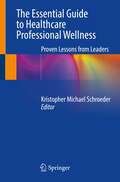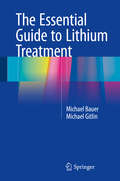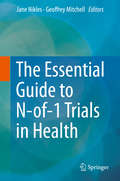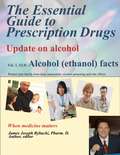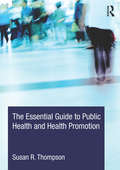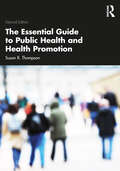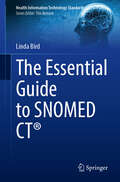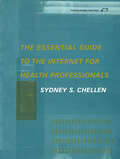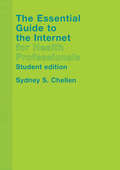- Table View
- List View
The Essence of Invention: Medicine and the Joy of Creativity
by Kieran MurphyMeet the brilliant mavericks who invented the future of medicine and saved the lives of millions.The Essence of Invention tells the story of medical inventors who have laid the foundation for modern patient care, from the development of anaesthesia and safe surgery to the advent of vaccines against smallpox, polio, and Covid-19, and how, through creativity and persistence, they have changed the world. The same kind of energy that drove Van Gogh or the Beatles can manifest itself in medicine as inventiveness and the creation of new medical devices. The field may feel very different from what is traditionally considered a creative industry, but the fundamental motivation and aspiration to create and the conviction and resilience needed to do so are the same. Dr. Murphy celebrates the creative energy of courageous men and women, honours their unique gifts, and explains how a culture of creativity and collaboration can and must be established around them to allow their talents to take flight.
The Essence of Leadership: Maintaining Emotional Independence in Situations Requiring Change
by Jaco J. Hamman Derek W. AndersonThe world is experiencing a leadership crisis. The Essence of Leadership addresses this concern by empowering self-differentiated leadership. The authors draw on family systems thinking, foundational to family therapy, psychodynamic theory, a recognized lens on human nature, and proven process management tools. The core message explored over seven chapters is that a leader’s management of their own anxiety and the anxiety in a system has direct implications for their effectiveness in bringing change. The authors believe that leadership is mastering emotional and relational processes seeking to bring change according to clearly defined goals and ethical principles. As such, leadership is poorly defined as a cognitive-rational, economic, charismatic, democratic, data-based, or expert-driven "How to …" skill. Rather, anxiety’s flow and management greatly determine the likelihood of systemic transformation. After reading this book, leaders will be empowered with a growing understanding of the role anxiety plays in systemic change even as they are equipped to lead with less anxiety. Though the theory and practices in the book are applicable to all leaders, leadership is illustrated through numerous case studies from their extensive experience empowering leaders in both the for profit and nonprofit sectors. Callouts throughout the book, along with questions for reflection, invite the reader into deeper contemplation.
The Essence of Multivariate Thinking: Basic Themes and Methods (Multivariate Applications Series)
by Lisa L. HarlowBy focusing on underlying themes, this book helps readers better understand the connections between multivariate methods. For each method the author highlights: the similarities and differences between the methods, when they are used and the questions they address, the key assumptions and equations, and how to interpret the results. The concepts take center stage while formulas are kept to a minimum. Examples using the same data set give readers continuity so they can more easily apply the concepts. Each method is also accompanied by a worked out example, SPSS and SAS input, and an example of how to write up the results. EQS code is used for the book’s SEM applications. ?This extensively revised edition features: New SEM chapters including an introduction (ch.10), path analysis (ch.11), confirmatory factor analysis (ch.12), and latent variable modeling (ch.13) the last three with an EQS application. A new chapter on multilevel modeling (ch. 8) that is now used more frequently in the social sciences. More emphasis on significance tests, effect sizes, and confidence intervals to encourage readers to adopt a thorough approach to assessing the magnitude of their findings. A new data set that explores the work environment. More discussion about the basic assumptions and equations for each method for a more accessible approach. New examples that help clarify the distinctions between methods. A new website at https://sites.google.com/site/multivariatesecondedition/ that features the datasets for all of the examples in the book for use in both SPSS and SAS and in EQS for the SEM chapters. The first two chapters review the core themes that run through most multivariate methods. The author shows how understanding multivariate methods is much more achievable when we notice the themes that underlie these statistical techniques. This multiple level approach also provides greater reliability and validity in our research. After providing insight into the core themes, the author illustrates them as they apply to the most popular multivariate methods used in the social, and behavioral sciences. First, two intermediate methods are explored – multiple regression and analysis of covariance. Next the multivariate grouping variable methods of multivariate analysis of variance, discriminant function analysis, and logistic regression are explored. Next the themes are applied to multivariate modeling methods including multilevel modeling, path analysis, confirmatory factor analysis, and latent variable models that include exploratory structural methods of principal component and factor analysis. The book concludes with a summary of the common themes and how they pertain to each method discussed in this book. ?Intended for advanced undergraduate and/or graduate courses in multivariate statistics taught in psychology, education, human development, business, nursing, and other social and life sciences, researchers also appreciate this book‘s applied approach. Knowledge of basic statistics, research methods, basic algebra, and finite mathematics is recommended.
The Essence of Multivariate Thinking: Basic Themes and Methods (Multivariate Applications Series)
by Lisa L. HarlowFocusing on the underlying themes that run through most multivariate methods, in this fully updated 3rd edition of The Essence of Multivariate Thinking Dr. Harlow shares the similarities and differences among multiple multivariate methods to help ease the understanding of the basic concepts. The book continues to highlight the main themes that run through just about every quantitative method, describing the statistical features in clear language. Analyzed examples are presented in 12 of the 15 chapters, showing when and how to use relevant multivariate methods, and how to interpret the findings both from an overarching macro- and more specific micro-level approach that includes focus on statistical tests, effect sizes and confidence intervals. This revised 3rd edition offers thoroughly revised and updated chapters to bring them in line with current information in the field, the addition of R code for all examples, continued SAS and SPSS code for seven chapters, two new chapters on structural equation modeling (SEM) on multiple sample analysis (MSA) and latent growth modeling (LGM), and applications with a large longitudinal dataset in the examples of all methods chapters. Of interest to those seeking clarity on multivariate methods often covered in a statistics course for first-year graduate students or advanced undergraduates, this book will be key reading and provide greater conceptual understanding and clear input on how to apply basic and SEM multivariate statistics taught in psychology, education, human development, business, nursing, and other social and life sciences.
The Essence of Play: A Practice Companion for Professionals Working with Children and Young People
by Justine Howard Karen McInnesA unique companion to professional play practice! All play professionals are united in their belief that play is important for children’s development – and there are inherent characteristics of play that underpin professional play practice across contexts. Providing an overarching concept of play, drawing together the evidence base across disciplines and linking theory to practice, The Essence of Play is the ideal handbook for all those working with children. Play acts as a natural resource for children to meet physical, intellectual and emotional challenges and this book, unusually, considers play from the perspectives of children rather than adults. It provides a baseline of shared knowledge for all play professionals, exploring the fundamental value of play rather than a ‘how to’ approach to practice. It considers: the therapeutic potential inherent in play; how play reflects and promotes physical, emotional, intellectual, linguistic and social abilities; the emergence of different types of play skills and why these are important; cross-cultural patterns in play, gender, atypicality and adversity, highlighting the relevance of these issues to professional play practice; the benefits of utilising play for assessment and other professional practice issues such as ethical play practice, balancing risk with health and safety and the creation and management of boundaries. This text is designed for students and practitioners working with children across the helping professions, including early years education, play therapy, playwork, childcare, social care, nursing and allied health. Each chapter provides directed reading and small reflective tasks to encourage readers to digest key issues.
The Essential Alkaline Diet Cookbook: 150 Alkaline Recipes to Bring Your Body Back to Balance and 3 Meal Plans to Meet Your Needs
by Rockridge PressFight dietary diseases and bring pH balance back to your body with 150 Alkaline recipes.Why eat according to pH? The Alkaline Diet helps create more alkaline environments in our bodies, which can combat diet-related diseases. Serving a number of lifestyle benefits, the Alkaline Diet improves bone health, cholesterol, blood pressure, cardiovascular health, and much more. With ailment-specific recipes and a 30-day meal plan to ensure success, The Essential Alkaline Diet Cookbook makes cooking balanced, nourishing meals easier than ever.The Essential Alkaline Diet Cookbook offers:150 Satisfying Recipes that will naturally bring your system back to balance with low-sodium, low-sugar, low-fat, high-fiber, and antioxidant rich meals30-Day Meal Plan for supporting your immune system, thyroid, or kidneysAn Essential Overview of the Alkaline Diet, including a handy list of the alkaline or acidic values of nearly 200 foodsAlkaline Diet recipes include: Almond-Quinoa Muffins, Quinoa and Avocado Salad, Vegetable Potpie, Championship Chili, Lovers' Lasagna.Taste the benefits of a pH balanced diet with The Essential Alkaline Diet Cookbook.
The Essential Anatomy of Melancholy
by Robert BurtonEnglish churchman and scholar Robert Burton (1577-1640) was a passionate student of medicine, history, literature, and science — the whole of human knowledge. This witty and eloquent genius devoted most of this life to writing The Anatomy of Melancholy, one of the richest, most inexhaustible books in the English language.Ostensibly an elaborately systematized medical treatise dealing with various morbid mental states — their causes, symptoms, and cures — the Anatomy is much more: a compendium of memorable utterances on the human condition in general, compiled from classical, scholastic, and contemporary sources. For this edition, the editors carefully selected passages of the most psychological and general interest, eliminating the nonessential material but retaining the incomparable humor, eccentric charm, imagination, and thought-provoking appeal of the original.In short, readers will find here the essence of Burton's vast book — the passages that, according to noted scholar W. H. D. Rouse, reveal the author's "eternal freshness, his own ingenuous interest, [and] his boyish delight in a good story."
The Essential Brain Injury Guide
by Brain Injury Association of AmericaThis manual provides a body of knowledge that can be utilized in preparation for brain injury specialist certification.
The Essential Dementia Care Handbook: A Good Practice Guide
by Fiona GoudieReplacing the successful "Working with Dementia", this edition draws together many new ideas and practical approaches from a wide variety of professionals working at the leading edge of the provision of services to people with dementia and provides a comprehensive account of current best practice. Beginning with the diagnosis of dementia and other problems associated with aging, this book considers assessment, the person centered model of dementia, rehabilitation and therapy. It outlines practical interventions, illustrated with case studies that provide a stimulating insight into contemporary understanding and practice. Nursing staff, occupational therapists, residential care workers, social workers and all those in day-to-day contact with elderly people will be inspired by this vital handbook for all care staff.
The Essential Difference: Male and Female Brains and the Truth About Autism
by Simon Baron-CohenWe all know the opposite sex can be a baffling, even infuriating, species. Why do most men use the phone to exchange information rather than have a chat? Why do women love talking about relationships and feelings with their girlfriends while men seem drawn to computer games, new gadgets, or the latest sports scores? Does it really all just come down to our upbringing? In The Essential Difference, leading psychologist Simon Baron-Cohen confirms what most of us had suspected all along: that male and female brains are different. This groundbreaking and controversial study reveals the scientific evidence (present even in one-day-old babies) that proves that female-type brains are better at empathizing and communicating, while male brains are stronger at understanding and building systems-not just computers and machinery, but abstract systems such as politics and music. Most revolutionary of all, The Essential Difference also puts forward the compelling new theory that autism (and its close relative, Asperger's Syndrome) is actually an example of the extreme male brain. His theory can explain why those who live with this condition are brilliant at analyzing the most complex systems yet cannot relate to the emotional lives of those with whom they live. Understanding our essential difference, Baron-Cohen concludes, may help us not only make sense of our partners' foibles, but also solve one of the most mysterious scientific riddles of our time.
The Essential Guide for Newly Qualified Occupational Therapists: Transition to Practice
by Nick Pollard Sean O'Sullivan Ruth Parker Julia Badger Ruth Van Weyden Dawn Simm Melanie Elliott Sara Brewin Jo McKee Kate Sheehan Dr Theresa BaxterStarting out in practice can be difficult and confusing. This guide for newly qualified occupational therapists provides an authoritative overview of what to expect in your role and work settings, and is full of practical guidance on how to make a good start to a successful practice. With chapters by experienced practitioners in the field, it offers insights into work in paediatrics, mental health, learning disability and the acute hospital setting. Vital information is also included on difficult aspects of practice such as legislation and data protection. It signposts sources for support and resources for furthering techniques in individual areas of work. Most importantly, the book offers tips for managing a busy workload, while building the positive relationships and resilience needed for a successful career in the occupational therapy.
The Essential Guide to Becoming a Staff Nurse
by Ian PeateWritten specifically for graduating students and newly registered nurses, this essential handbook will help you navigate the transition from student to registered practitioner. Providing you with the key knowledge to help consolidate your degree course, The Essential Guide to Becoming a Staff Nurse will enable you to become an autonomous and accountable practitioner. Covering everything the newly registered nurse needs to know, this handy book explores: How to get the job you want The role and function of the staff nurse Accountability and delegation Working with patients and their families Becoming a manager Continuing professional and personal development With activities, practical hints and tips throughout, this accessible aide-memoire will provide indispensable support for newly registered nurses in all fields.
The Essential Guide to Getting into Medical School
by Rajiv KaliaThis is a concise guide to getting into medical school. It covers everything you need to know without the long-winded explanations found in other books and online. The Essential Guide to Getting into Medical School prepares you for all eventualities, so you can be ready for every aspect of your application and address any shortcomings you may have which may otherwise hinder your chances. It offers helpful tips, tactics, questions and warnings to assist with decision making and personal preparedness. This book is ideal for students of any age, from GCSE onwards, including those applying as postgraduate students. It is also highly recommended for international students wanting detailed advice on how to secure admission.
The Essential Guide to Healthcare Professional Wellness: Proven Lessons from Leaders
by Kristopher Michael SchroederHealthcare professionals throughout the world heed a calling that compels them to devote their lives to the treatment of their patients. While this work is generally rewarding, these professionals frequently fall victim to stressors and happiness barriers that impact their ability to function at work, the longevity of their career and the quality of their relationships outside of the hospital. Burnout, diminished career fulfilment, substance abuse, and suicide data for healthcare professionals demonstrate that the risks to this population are incredibly real. Unfortunately, there is nothing to suggest that any of these stressors are improving as pandemics, access disparities, changes in healthcare system structure, and patient complexity further escalate work-related challenges. Thankfully, there are sources of help readily available to each of us. All healthcare professionals have encountered a colleague, mentor or expert who has already navigated or has a perspective on how to thrive in the setting of hardship. This book will organize the voices of these leaders in a way that provides readers with a source for advice and inspiration. Sections of chapters are dedicated to work-life balance, family, finances, faith, resiliency, and recovery. For those healthcare workers actively caring for patients and struggling with their career, this book will serve as a source of solace and inspiration that should help to reinvigorate and extend a successful career.
The Essential Guide to Lithium Treatment
by Michael Bauer Michael GitlinThis book is a practical, up-to-date guide to the correct use of lithium for the short- and long-term treatment of mood disorders. Among the subjects addressed are the pharmacology and mechanisms of action of lithium, its use for maintenance treatment, the role of lithium in the treatment of mania and depression and in suicide prevention, further clinical indications, the administration of lithium during pregnancy and the postpartum period, and adverse effects and their management. Relevant background information is provided on the diagnosis, classification, and natural course of mood disorders, and an overview of other treatments for bipolar disorder and major depression is included. Lithium is the essential medication for patients with mood disorders. The evidence of its efficacy in maintenance treatment is acknowledged in all major international treatment guidelines for bipolar disorders and, when used correctly, lithium unquestionably produces the most dramatic benefits of any medication in psychopharmacology. This essential guide is written by two international experts in the treatment of mood disorders who have more than 25 years of experience in the use of lithium and have authored numerous scientific articles on lithium.
The Essential Guide to N-of-1 Trials in Health
by Jane Nikles Geoffrey MitchellN-of-1 trials, a type of individualized randomized controlled trial, are relevant to almost every discipline in medicine and psychology. They can tell the clinician with precision whether a treatment works in that individual, which distinguishes from the information available from most other trial designs. They have the potential to revolutionize the way clinical medicine is practiced. Whether you are a busy clinician, a researcher or a student, this book provides everything you need to know about N-of-1 trials. Written and edited by some of the world's leading experts on N-of-1 trials, the book presents state of the art knowledge about N-of-1 trials, with chapters on ethics, statistics, health economics, design, analysis and reporting, and more. Full of examples and well illustrated, it is a comprehensive compendium of issues surrounding the design, conduct, interpretation and implementation of N-of-1 trials in a health system.
The Essential Guide to Prescription Drugs, Update on Alcohol
by James J Rybacki Pharm. D.The Essential Guide to Prescription Drugs, Update on alcohol is the latest edition of the widely acclaimed family of Essential Guide publications. From potentially life-saving drug interactions to preventing alcohol poisoning, the book is a must read for every family. Find out about key things to talk to your doctor about before drinking, 11 impacts on medicines and health drugs never to combine and even objective web sites to help.
The Essential Guide to Public Health and Health Promotion
by Susan R. ThompsonIn the twenty-first century, public health is everyone’s business. The nursing and medical professions are well placed to provide advice to their clients, especially in respect to lifestyle change, and public health initiatives are supported by a range of statutory and voluntary organisations and health workers, ranging from health promotion specialists to smoking cessation advisers and nutrition assistants. Designed to help readers develop the practical skills they need to become effective public health practitioners, this concise text gives an easily digested overview of public health and health promotion theory in accessible language and diagrams, before moving on to the ways readers can apply this in practice. Providing an opportunity for practitioners to understand possible barriers to lifestyle change, debate health inequalities and responsibilities, and explore the role of the media in changing attitudes, it: Outlines the roles of specific organisations involved in the work of public health work. Covers health needs assessment, agenda setting and the technical aspects of how to research plan and evaluate effective practice either with individual clients or when devising programmes and initiatives for population groups. Details methods of helping people with motivation for lifestyle change, building rapport, ongoing support, monitoring and signposting to specific services. Discusses role of neighbourhoods and communities in improving health and how workers may support local populations to improve the health of their community. The Essential Guide to Public Health and Health Promotion is an accessible introduction to the principles and practice of health promotion and public health for all those new to working or studying in the area, whatever their professional background.
The Essential Guide to Public Health and Health Promotion
by Susan R. ThompsonDesigned to help readers develop the practical skills needed to become effective public health practitioners, this concise text gives a highly accessible overview of the theory and practice of public health and health promotion. The book covers a comprehensive range of key topics, beginning with a discussion of theoretical models and approaches to public health, before addressing important issues such as equality, health education and governmental policy. It also offers readers: Information on health needs assessment, including how to research, plan and evaluate practice with individual clients or population groups. Methods of helping people with motivation for behaviour change, building rapport, ongoing support, and signposting to services. The role of communities in improving health and how to support local populations. In light of the Covid-19 pandemic, this 2nd edition has been updated with new material around vaccination and communicable disease and includes expanded coverage of mental health issues. There’s also a new ‘reflective thinking’ feature to encourage a more critical approach. The Essential Guide to Public Health and Health Promotion, 2nd edition is the ideal starting point for all those new to working or studying in the area, whatever their professional or academic background.
The Essential Guide to Religious Traditions and Spirituality for Health Care Providers
by Jeffers Steven Michael E Nelson Vern Barnet Michael C BranniganThis extraordinary compendium of religious traditions is invaluable to all healthcare providers. The user-friendly resource contains specific and detailed information on faith traditions vital for providing optimal spiritual care in a clinical setting. A series of inspirational introductory chapters promote the importance of spiritual well-being as
The Essential Guide to SNOMED CT® (Health Information Technology Standards)
by Linda BirdThis book is an essential guide to using SNOMED CT®. It emphasises SNOMED CT&’s® importance to healthcare and describes how it is used to improve patient outcomes and deliver more effective healthcare. The book explains the main design features fundamental to using SNOMED CT® as a clinical terminology, and the tools and processes used to develop and extend it. With these foundations in place, it then offers practical advice to implementing SNOMED CT® in a health information environment, highlighting the intrinsic relationship between terminology and information models, and exploring how different types of health data can be represented. The Essential Guide to SNOMED CT® offers guidance on how to customise the terminology for specific usages, by developing value sets, user-friendly terms, and new content. Effective principles and solutions for deploying terminology services, for designing user interfaces, and for storing, exchanging and querying SNOMED CT® data are also explored. The book concludes by discussing the role that SNOMED CT plays in semantic interoperability, and summarising some key messages for anyone using or planning to use SNOMED CT®.
The Essential Guide to the Internet for Health Professionals
by Sydney. S. ChellenThere is a wealth of health information on the Internet. Today’s students of health studies and all health care professionals must be able to use this valuable resource and extract from it what is most relevant and useful. In order for them to do this purposefully and skilfully, they need to have a thorough understanding of how the system works and have the ability to navigate their way around it with ease. The Essential Guide to the Internet for Health Professionals is a superb photocopiable resource for lecturers and a self instructional guide for students. It shows students how to: get online; navigate the World Wide Web; find health information on the Internet; communicate with other health professionals; access free health and medical resources; publish on the web; use online help with health studies assignments; search for jobs. Each unit contains easy-to-follow activities and photocopiable worksheets.
The Essential Guide to the Internet for Health Professionals: An Interactive Beginner's Handbook
by Sydney ChellenFirst published in 2003. Routledge is an imprint of Taylor & Francis, an informa company.
The Essential Guide to the New FRCR: Part 2A (MasterPass)
by David MaudgilThis book takes account of recent changes in the Fellowship of the Royal College of Radiologists (FRCR) Part 2A examination. It includes basic radiological science questions as well as the original clinical imaging component, and in particular it discusses cross sectional imaging at an advanced level. Many of these questions are also very useful in preparation for the American Boards Exam in Radiology. Unlike other books in this field, this essential guide provides full explanatory answers and bibliography. Questions are divided into subject chapters corresponding to those in the current FRCR Part 2A syllabus, and structured in an identical fashion to the actual exam.
The Essential Guide to the New FRCR: Pt. 1 (MasterPass)
by Tony Jeswani John MorleseThe focus of the new Fellowship of the Royal College of Radiologists (FRCR) Part 1 exam has shifted to examining the fundamental physics, and radiation protection required to work safely within a radiology department. This book presents the new syllabus in a multiple-choice format that parallels the new exam. In addition, short answer questions reinforce fundamental teaching points. This essential guide will not only enable candidates to sit the exam with confidence, but will help them achieve a better and long lasting understanding of the subject for their future careers.
